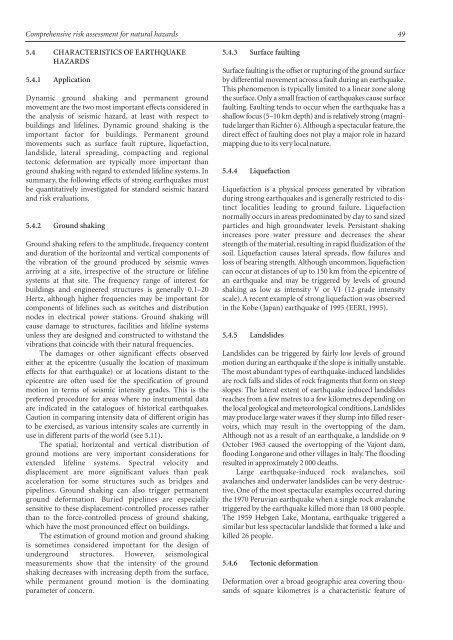Comprehensive Risk Assessment for Natural Hazards - Planat
Comprehensive Risk Assessment for Natural Hazards - Planat
Comprehensive Risk Assessment for Natural Hazards - Planat
You also want an ePaper? Increase the reach of your titles
YUMPU automatically turns print PDFs into web optimized ePapers that Google loves.
<strong>Comprehensive</strong> risk assessment <strong>for</strong> natural hazards<br />
5.4 CHARACTERISTICS OF EARTHQUAKE<br />
HAZARDS<br />
5.4.1 Application<br />
Dynamic ground shaking and permanent ground<br />
movement are the two most important effects considered in<br />
the analysis of seismic hazard, at least with respect to<br />
buildings and lifelines. Dynamic ground shaking is the<br />
important factor <strong>for</strong> buildings. Permanent ground<br />
movements such as surface fault rupture, liquefaction,<br />
landslide, lateral spreading, compacting and regional<br />
tectonic de<strong>for</strong>mation are typically more important than<br />
ground shaking with regard to extended lifeline systems. In<br />
summary, the following effects of strong earthquakes must<br />
be quantitatively investigated <strong>for</strong> standard seismic hazard<br />
and risk evaluations.<br />
5.4.2 Ground shaking<br />
Ground shaking refers to the amplitude, frequency content<br />
and duration of the horizontal and vertical components of<br />
the vibration of the ground produced by seismic waves<br />
arriving at a site, irrespective of the structure or lifeline<br />
systems at that site. The frequency range of interest <strong>for</strong><br />
buildings and engineered structures is generally 0.1–20<br />
Hertz, although higher frequencies may be important <strong>for</strong><br />
components of lifelines such as switches and distribution<br />
nodes in electrical power stations. Ground shaking will<br />
cause damage to structures, facilities and lifeline systems<br />
unless they are designed and constructed to withstand the<br />
vibrations that coincide with their natural frequencies.<br />
The damages or other significant effects observed<br />
either at the epicentre (usually the location of maximum<br />
effects <strong>for</strong> that earthquake) or at locations distant to the<br />
epicentre are often used <strong>for</strong> the specification of ground<br />
motion in terms of seismic intensity grades. This is the<br />
preferred procedure <strong>for</strong> areas where no instrumental data<br />
are indicated in the catalogues of historical earthquakes.<br />
Caution in comparing intensity data of different origin has<br />
to be exercised, as various intensity scales are currently in<br />
use in different parts of the world (see 5.11).<br />
The spatial, horizontal and vertical distribution of<br />
ground motions are very important considerations <strong>for</strong><br />
extended lifeline systems. Spectral velocity and<br />
displacement are more significant values than peak<br />
acceleration <strong>for</strong> some structures such as bridges and<br />
pipelines. Ground shaking can also trigger permanent<br />
ground de<strong>for</strong>mation. Buried pipelines are especially<br />
sensitive to these displacement-controlled processes rather<br />
than to the <strong>for</strong>ce-controlled process of ground shaking,<br />
which have the most pronounced effect on buildings.<br />
The estimation of ground motion and ground shaking<br />
is sometimes considered important <strong>for</strong> the design of<br />
underground structures. However, seismological<br />
measurements show that the intensity of the ground<br />
shaking decreases with increasing depth from the surface,<br />
while permanent ground motion is the dominating<br />
parameter of concern.<br />
5.4.3 Surface faulting<br />
Surface faulting is the offset or rupturing of the ground surface<br />
by differential movement across a fault during an earthquake.<br />
This phenomenon is typically limited to a linear zone along<br />
the surface. Only a small fraction of earthquakes cause surface<br />
faulting. Faulting tends to occur when the earthquake has a<br />
shallow focus (5–10 km depth) and is relatively strong (magnitude<br />
larger than Richter 6).Although a spectacular feature, the<br />
direct effect of faulting does not play a major role in hazard<br />
mapping due to its very local nature.<br />
5.4.4 Liquefaction<br />
Liquefaction is a physical process generated by vibration<br />
during strong earthquakes and is generally restricted to distinct<br />
localities leading to ground failure. Liquefaction<br />
normally occurs in areas predominated by clay to sand sized<br />
particles and high groundwater levels. Persistant shaking<br />
increases pore water pressure and decreases the shear<br />
strength of the material, resulting in rapid fluidization of the<br />
soil. Liquefaction causes lateral spreads, flow failures and<br />
loss of bearing strength. Although uncommon, liquefaction<br />
can occur at distances of up to 150 km from the epicentre of<br />
an earthquake and may be triggered by levels of ground<br />
shaking as low as intensity V or VI (12-grade intensity<br />
scale).A recent example of strong liquefaction was observed<br />
in the Kobe (Japan) earthquake of 1995 (EERI, 1995).<br />
5.4.5 Landslides<br />
Landslides can be triggered by fairly low levels of ground<br />
motion during an earthquake if the slope is initially unstable.<br />
The most abundant types of earthquake-induced landslides<br />
are rock falls and slides of rock fragments that <strong>for</strong>m on steep<br />
slopes. The lateral extent of earthquake induced landslides<br />
reaches from a few metres to a few kilometres depending on<br />
the local geological and meteorological conditions. Landslides<br />
may produce large water waves if they slump into filled reservoirs,<br />
which may result in the overtopping of the dam.<br />
Although not as a result of an earthquake, a landslide on 9<br />
October 1963 caused the overtopping of the Vajont dam,<br />
flooding Longarone and other villages in Italy. The flooding<br />
resulted in approximately 2 000 deaths.<br />
Large earthquake-induced rock avalanches, soil<br />
avalanches and underwater landslides can be very destructive.<br />
One of the most spectacular examples occurred during<br />
the 1970 Peruvian earthquake when a single rock avalanche<br />
triggered by the earthquake killed more than 18 000 people.<br />
The 1959 Hebgen Lake, Montana, earthquake triggered a<br />
similar but less spectacular landslide that <strong>for</strong>med a lake and<br />
killed 26 people.<br />
5.4.6 Tectonic de<strong>for</strong>mation<br />
De<strong>for</strong>mation over a broad geographic area covering thousands<br />
of square kilometres is a characteristic feature of<br />
49

















